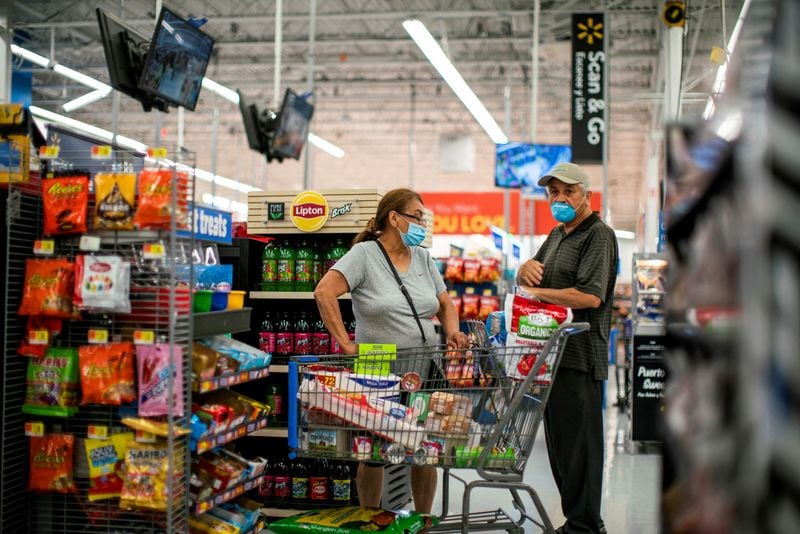By Lucia Mutikani
WASHINGTON – U.S. consumer confidence dropped to a 16-month low in June as worries about high inflation left consumers to anticipate that the economy would slow significantly or even slide into recession in the second half of the year.
Despite the gloomy outlook, consumers showed little sign of cutting back on spending, with buying plans for motor vehicles and other big ticket items like refrigerators and washing machines increasing, the survey from the Conference Board on Tuesday showed. But fewer consumers compared to April intended to go away on vacation at home or abroad, reflecting record high gasoline prices and expensive airfares.
The economy is on recession watch as the Federal Reserve aggressively tightens monetary policy to tackle inflation. For now, it continues to grow, with other data on Tuesday showing the goods trade deficit again narrowing significantly in May as exports hit a record high.
“Right now we are at an inflection point in the economy, where actual spending and economic activity is still positive, however, consumer confidence and financial conditions, especially interest rates, are indicating a slowdown ahead,” said Chris Zaccarelli, chief investment officer at Independent Advisor Alliance in Charlotte, North Carolina.
The Conference Board’s consumer confidence index dropped 4.5 points to a reading of 98.7 this month, the lowest since February 2021. Consumers’ assessment of current business and labor market conditions were little changed. But their short-term outlook for income, business and labor market conditions were the weakest since March 2013, which the Conference Board said were “suggesting weaker growth in the second half of 2022 as well as growing risk of recession by year end.”
Consumer fears of a recession could become self-fulfilling. The University of Michigan’s survey last week showed consumer sentiment plunging to a record low in June.
The Conference Board survey places more emphasis on the labor market, which remains tight, but consumers are feeling the inflation pain. National gasoline prices averaged just above $5 per gallon for most of June, before slipping back to around $4.88 per gallon as of Tuesday, according to data from AAA.
“Consumers hate inflation and this is depressing consumer confidence via the expectation channel even as households see labor market conditions as strong,” said Conrad DeQuadros, senior economic advisor at Brean Capital in New York.
The Conference Board survey’s so-called labor market differential, derived from data on respondents’ views on whether jobs are plentiful or hard to get, ticked up to 39.7 from a reading of 39.5 in May. This measure correlates to the unemployment rate from the Labor Department.
There were 11.4 million job openings at the end of April, with nearly 2 openings per every unemployed person.
Stocks on Wall Street were mostly lower. The dollar rose against a basket of currencies. U.S. Treasury prices fell.
INFLATION EXPECTATIONS JUMP
Consumers’ inflation expectations over the next 12 months jumped to a record high 8.0% from 7.5% in May.
The Fed this month raised its policy rate by three-quarters of a percentage point, its biggest hike since 1994. The U.S. central bank has increased its benchmark overnight interest rate by 150 basis points since March.
Consumers still intend to keep on spending on goods even as they worry about inflation. The share of consumers planning to buy a motor vehicle over the next six months rose. More consumers planned to buy major household appliances, including dryers and vacuum cleaners.
But vacation is not on the cards for many, which could slow consumer spending and economic growth in the second half.
Plans to buy a home were unchanged as borrowing costs increase further and house prices remain elevated amid a shortage of entry-level homes.
A separate report on Tuesday showed the S&P CoreLogic Case-Shiller national home price index increased 20.4% on a year-on-year basis in April after surging a record 20.6% in March. Hefty price gains were recorded in Tampa, Miami and Phoenix.
Signs that house price inflation has probably peaked were reinforced by a third report from the Federal Housing Finance Agency showing home prices increased 18.8% in the 12 months through April after accelerating 19.1% in March.
Nevertheless, the economy is chugging along. A fourth report from the Commerce Department showed the goods trade deficit contracted 2.2% to $104.3 billion in May, suggesting that trade could contribute to economic growth this quarter for the first time in nearly two years.
A record trade deficit weighed on the economy in the first quarter, resulting in gross domestic product declining at a 1.5% annualized rate. Trade has subtracted from GDP for seven straight quarters. Growth estimates for the second quarter range from as low as a 0.3% rate to as high as a 2.9% pace.
Wholesale inventories increased 2.0% in May, while stocks at retailers climbed 1.1%.
“Exports and inventories are still rising in May at least, and this means the recession clouds offshore will have to sit on the horizon for another month,” said Christopher Rupkey, chief economist at FWDBONDS in New York.
(Reporting by Lucia Mutikani; Editing by Paul Simao and Chizu Nomiyama)
